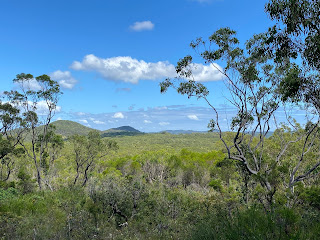My ‘home’ for the next little while is with a friend who lives in Point Clare, which is in the area known as the Central Coast - just north of Sydney, on the east coast of New South Wales.
This is the view from my bedroom window
And down a little bit lower on their deck. The water is a little bay called Waterfall Bay which is a part of Broken Bay.
This became ‘my’ chair for coffee in the morning!
Went for a little walk along a beautiful walking path that goes for kilometres around the bay.
The walk took me to a nearby town called Woy Woy - isn’t that a great name!
A specific area set up for swimming - and although sharks aren’t likely in these shallower waters nothing is guaranteed.
Looking down on Woy Woy Bay
A lovely little walk in Brisbane Water National Park.
A banksia flower. There are around 170 species of flowering plants in the family Proteaceae. Heavy producers of nectar, banksias are a vital part of the food chain in the Australian bush. They are an important food source for nectarivorous animals, including birds, bats, rats, possums, stingless bees and a host of invertebrates.
Eucalyptus haemastoma, commonly known as Scribbly Gum trees, are endemic to the Sydney region.
You can also see engravings of wallabies, fish, a dolphin and what’s thought to be a canoe and a bird. Unfortunately I couldn’t get photos of them all, just because of where they were positioned on the rocks, but they were quite amazing to see!
In the late 18th century, shipping between Sydney and Newcastle was perilous. Thick fog, fierce gales, jagged rocks and black-out conditions often encountered along the coast claimed the lives of many on the sea. In 1901 construction of the Norah Head Lighthouse began and it was completed in 1903. A vaporized kerosene burner and mantle originally illuminated the Norah Head beam, in 1961 the kerosene burner was removed in favour of electricity, and in 1995 the light became fully automated.
These two lovely cabins were once the Lighthouse Keeper’s Quarters. They have been lovingly restored and are now accommodation.
Definitely a very rocky coast around Norah Head headland and I have no doubt the South Pacific Ocean could make for rough sailing!
A bit further down the coast there are some lovely beach areas
and The Rockpool at Norah Head is a wonderful sheltered spot for swimming.
More frangiapani - they’re just lovely flowers and the smell is wonderful!
The Entrance is another coastal town, south of Norah Head. The town occupies a promontory bounded by water on three sides. The Entrance gains its name from the channel that runs along much of its northern border that is ‘the entrance’ to Tuggerah Lakes.
The Entrance channel and Tuggerah Lakes are home to many wild pelicans who have become a well known icon in the region. Occasionally volunteers from Marine Wildlife Rescue do educational talks covering interesting facts on pelicans, care and rescue of pelicans in the wild, and ways that we can all help protect pelicans and their environment.












































No comments:
Post a Comment